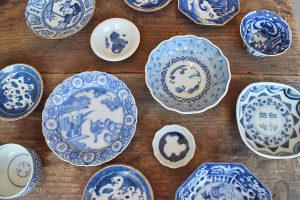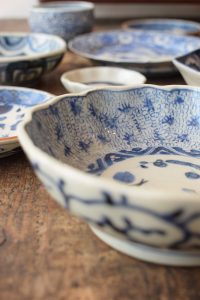青の染付が気になります。(風光舎 名古屋店より)
2021.02.17
今日も寒い名古屋ですが、みなさまいかがおすごしでしょうか?
自分の中で時期によって好きな色が変わっていくのですが、最近青色が気になります。

先週から始まったNHKの大河ドラマ〝青天を衝け〟。
舞台は、武蔵国血洗島(現在の埼玉県深谷市)の藍畑や藍玉の生産など青天の青も加わり青の世界が素晴らしく表現されていますね。藍で染まっている手や身に着けているお着物、大切に育て作った藍とともに暮らしていたんでしょう。今後の展開がとても楽しみです。
器などにも青の染付が現在でもよく使われていまして、ここ古美術風光舎名古屋店にも、青の染付の器がたくさんあり、それぞれ絵付け、図柄など違いがありまして、同じものはひとつとなく、お店にて小さな青の世界をつくっております。
染付の意味を補足しますと、
藍色一色で文様が描かれたものを染付(そめつけ)といい、中国から伝わってきたのですね、中国では青花(せいか)、朝鮮半島では青華白磁といいます。技法は、白い素地に呉須(ごす)という絵具で絵付けし、透明釉をかけて焼成するというものです。呉須は酸化コバルトを含む鉱物で、天然ものは昔から希少であったため江戸時代でも中国から輸入されていました。藍色に発色するのは呉須が酸化コバルトを含んでいるためで、約1300度の温度と酸素の少ない還元炎(かんげんえん)で焼成されて発色します。ひとくちに藍色といっても、淡いものや黒みを帯びたものなど色合いはさまざまで、発色の微妙な変化を楽しむのも染付の醍醐味といえるでしょう。染付技法のルーツは中国にありますが、すでに宋の時代から試みられ、14世紀の元時代には素晴らしい染付が完成しています。その人気は高く、西アジアやアフリカにまで輸出されるほどでした。日本の染付は17世紀の初め、渡来した朝鮮陶工たちの手によって有田で始まりました。
染付の広がりは、時中国・朝鮮・日本といった東アジア、ベトナムなどの東南アジア、トルコ・イランなどイスラム文化圏の西アジア、さらには欧州にまで、青のうつわへの憧れと声望、その生産は、地理的にも空前の伝播力で広まってゆきました。近年、中国における青花の完成に、西アジアの文化と人々が大きな役割を果たしたことが指摘されています。その背後には、紀元前後からシリアや東地中海地域で作られた青色ガラス器や、イスラム教寺院を飾る壮麗な青色タイルなど、この地域で育まれた「青」の伝統が垣間見えます。

こちらの器、暫く凝視してみていましたよ。実に細かい筆で描いていますね。

こちらは、ドラゴン柄。深く濃い青に染付しています。
快晴の空や海を想わせる青のかがやきに、昔から世界中の国や人々がひとしく心を酔わせていた染付。
かつての人々や他国と繋がる青の世界、もう少し眺めていたいですね。
It’s cold in Nagoya today, but how are you all doing?
My favorite color changes depending on the time of year, but recently I’m interested in blue.
NHK’s taiga drama “Seiten wo tuke” that started last week.
The stage is a wonderful expression of the blue world with the addition of the blue of the blue sky, such as the indigo field of Musashi Province Chiaraijima (currently Fukaya City, Saitama Prefecture) and the production of indigo balls. You probably lived with your hands dyed with indigo, the kimono you wore, and the indigo you carefully raised and made. I am very much looking forward to future developments.
Blue and white ware is still often used for vessels, and there are many blue and white wares here at the Ancient Art Fukosha Nagoya store, each with different paintings and patterns. We are creating a small blue world at the store.
To supplement the meaning of dyeing,
The one with the pattern drawn in indigo is called dyeing, and it came from China. In China, it is called blue flower, and in the Korean Peninsula, it is called blue and white porcelain. The technique is to paint a white base with a paint called Gosu, apply a transparent glaze, and fire it. Kuresu is a mineral containing cobalt oxide, and since natural products have been rare for a long time, they were imported from China even during the Edo period. The indigo color develops because Kuresu contains cobalt oxide, and it is fired at a temperature of about 1300 degrees Celsius and a reducing flame with little oxygen. Even if it is called indigo, there are various shades such as pale and blackish ones, and it can be said that the real pleasure of dyeing is to enjoy the subtle changes in color development. The roots of the dyeing technique are in China, but it has already been tried since the Song dynasty, and in the Yuan dynasty of the 14th century, wonderful dyeing was completed. Its popularity was so high that it was even exported to West Asia and Africa. Japanese dyeing began in Arita at the beginning of the 17th century by the hands of Korean potters who arrived.
The spread of dyeing has spread to East Asia such as China, Korea, and Japan, Southeast Asia such as Vietnam, West Asia of Islamic culture such as Turkey and Iran, and even Europe, longing and desire for blue containers, and their production. , Geographically, it spread with unprecedented transmission power. In recent years, it has been pointed out that Western Asian culture and people have played a major role in the completion of blue and white flowers in China. Behind it, you can get a glimpse of the “blue” tradition that has been nurtured in the region, such as the blue glassware made in Syria and the eastern Mediterranean region from around AD and the magnificent blue tiles that decorate Islamic temples.
I’ve been staring at this vessel for a while. You draw with a really fine brush.
This is a dragon pattern. It is dyed deep dark blue.
The blue and white brilliance reminiscent of the clear sky and the sea has long been intoxicating to countries and people around the world.
I would like to see a little more about the blue world that connects with the people of the past and other countries.
*********************
自粛期間中に、ご自宅のお片付けをされていらっしゃる方も、おありでしょうか。
行先に迷われたお品などございましたら、どうぞお気軽にご相談下さい。
愛知県内はもちろん、岐阜県、三重県その他の県の方も、出張いたします。
古美術風光舎 名古屋店(10:00~17:00 OPEN)

